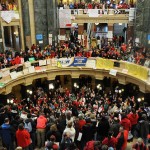The Constitutional Right of Recall
 The largest newspaper in Wisconsin, the Milwaukee Journal-Sentinel, continues to take the editorial position that the public’s right to recall elected officials should only be exercised in cases of misfeasance in office or of criminal conduct. The editorial page actively disparages the use of the recall process in cases where voters simply disagree with the policy choices of their elected representatives. Recent examples of this editorial position can be seen here, and in the decision to excerpt a similar editorial published by the newspaper USA Today here. On this past Sunday, Steven Walters commented in the Journal-Sentinel on possible amendments to the Wisconsin Constitution intended to modify the existing recall provisions and to bring them into line with the more limited scope advocated by these editorials.
The largest newspaper in Wisconsin, the Milwaukee Journal-Sentinel, continues to take the editorial position that the public’s right to recall elected officials should only be exercised in cases of misfeasance in office or of criminal conduct. The editorial page actively disparages the use of the recall process in cases where voters simply disagree with the policy choices of their elected representatives. Recent examples of this editorial position can be seen here, and in the decision to excerpt a similar editorial published by the newspaper USA Today here. On this past Sunday, Steven Walters commented in the Journal-Sentinel on possible amendments to the Wisconsin Constitution intended to modify the existing recall provisions and to bring them into line with the more limited scope advocated by these editorials.
I have commented on this issue before. The editorial position of the Milwaukee Journal-Sentinel is misguided. In particular, in editorializing against the exercise of the recall power, the Journal-Sentinel fails to account for both the specific text of the Wisconsin Constitution and the understanding of the recall power among the founding generation of our country. The key to understanding the proper scope of the recall power is the basic conception of “the sovereignty of the people.”

